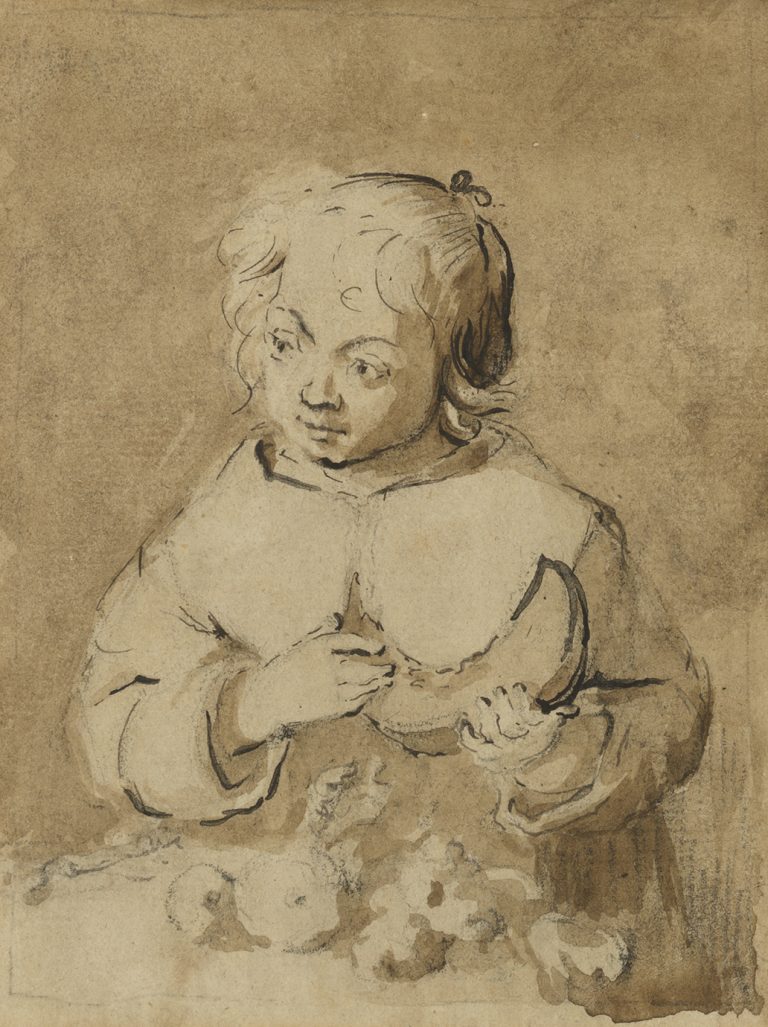The girl holding a slice of melon in both hands looks to her right, where something apparently has grabbed her attention. More fruit, or some other unidentifiable food, lie in front of her. She wears a wide white collar over her dress; her hair is tied behind her head with a bow, but some loose strands hang over her forehead. Gerard ter Borch the Younger laid in the drawing with black chalk and then worked it up in pen and brown ink, sometimes to reinforce the contours. He also applied a brown wash to shade one side of the girl’s face and to cover the background. This wash strengthens the effect of light falling on her face and clothing.
Apart from landscapes drawn in Italy,1 Ter Borch made only a few known drawings “from life.” Among these is a group from the early 1630s, to which this work belongs, in which he depicted the two daughters he had with his second wife, Geesken van Voerst (1599–in or before 1628).2 The elder daughter, Anna, was born on 27 October 1622, and the younger, Sara, on 23 July 1624.3 Even though he later had more daughters with his third wife, none of them is likely to be the subject of this drawing, as they were not born until the second half of the 1630s. Furthermore, Ter Borch made very few drawings after the mid-1630s, which bolsters the argument that this work dates from the early 1630s.4
Gerard ter Borch the Elder had a number of children, all of whom drew under his supervision, no doubt taking his drawings as their example. Drawing from life, particularly the human figure, was, like drawing from the imagination, an important part of artistic instruction. Ter Borch frequently annotated and dated the drawings made by his sons Gerard the Younger (1617–81), Harmen (1638–77), and Mozes (1645–67), and in a number of instances he noted that they had been made “from life.” On the verso of Gerard the Younger’s drawing Head of a Girl, he wrote “15 December 1633.”5 This work, and a comparable drawing of a young girl, may have been inspired by Gerard the Elder’s Little Girl at a Table Holding a Slice of Melon, and, indeed, may represent the same model.6 Watching his father draw the girls may well have prompted Gerard the Younger to execute his own versions.
Gerard the Elder’s drawing probably depicts Sara. She is likely also portrayed in the drawing Bust-Length Portrait of a Girl with a Necklace, in Amsterdam’s Rijksprentenkabinet (fig 1). Her face was slightly less narrow than that of her sister Anna,7 who is depicted—looking somewhat older—in the drawing Girl Reading, likewise in Amsterdam.8 The girl wearing a necklace has the same spontaneous look and loose wisps of hair gracing her forehead as the girl in the present drawing. She is shown wearing a necklace again in a drawing in an album—likewise preserved in Amsterdam—later compiled by her younger half-sister, Gesina ter Borch (1631–90) (fig 2).9
It was not unusual for Dutch artists, Rembrandt among them, to seek models from their immediate family circle. Nevertheless, this practice was particularly evident in the Ter Borch family. Not only did Ter Borch the Elder regularly depict his children, but Gerard the Younger also portrayed Sara, Gesina,10 and his half-brother Mozes.11 Surviving works by Mozes include drawings he made of his parents12 and of Gesina.13
The drawings in Amsterdam come from the Ter Borch family estate, which remained intact until the late nineteenth century before it was finally sold at auction in 1886.14 Most of those works were subsequently acquired by the Rijksmuseum. It was Gesina who preserved this estate, which also included the drawings and watercolors she made along with those by her siblings, which had been kept by their father.15 Altogether these drawings, which number more than a thousand, present a unique picture of a studio legacy that has no parallel in work from the seventeenth century. It is likely that the hundred or so drawings by members of the Ter Borch family that can be found in other collections had already been sold or given away in the seventeenth century.
